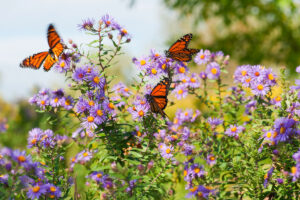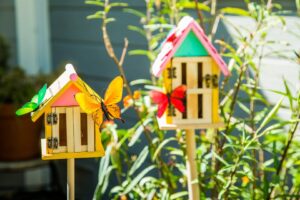Transform your backyard into a vibrant butterfly haven with our comprehensive guide on building a butterfly garden.
Choosing the Perfect Location for Your Butterfly Garden
Selecting the right location for your butterfly garden is crucial for attracting these delightful creatures. Butterflies thrive in sunny areas, so choose a spot that receives at least 6 hours of sunlight each day. Avoid locations that are too windy, as butterflies prefer calm environments.
Consider placing your garden near a natural shelter, such as trees or shrubs, which can provide protection from strong winds and predators. Additionally, ensure that the area has good drainage to prevent water from pooling around the plants.

Selecting the Right Plants to Attract Butterflies
The key to a successful butterfly garden lies in the plants you choose. Opt for a variety of nectar-rich flowers, such as milkweed, coneflowers, and lantanas, which are known to attract butterflies. Planting a mix of annuals and perennials will ensure that your garden has blooms throughout the growing season.
In addition to nectar plants, include host plants where butterflies can lay their eggs. For example, monarch butterflies lay their eggs on milkweed, while black swallowtails prefer parsley and dill. Research the native butterfly species in your area to select the best plants for your garden.
Check out this list from Preen, Top 10 Plants to attract butterflies.
Creating a Water Source for Thirsty Butterflies
Butterflies need a reliable water source to stay hydrated, especially during hot summer days. A simple way to provide water is by creating a butterfly puddling station. Fill a shallow dish with sand and add water until the sand is thoroughly moist. Butterflies can then sip water from the sand without the risk of drowning.
You can also create small puddles by placing stones or pebbles in a shallow dish and adding water. The stones will give butterflies a safe place to land and drink. Make sure to refill the water source regularly to keep it clean and fresh.

Providing Shelter and Nesting Sites for Butterflies
Shelter is essential for butterflies to rest and escape from harsh weather conditions. Incorporate dense shrubs, tall grasses, and trees into your garden design to offer natural hiding spots. You can also add artificial shelters, like butterfly houses, to provide additional protection.
Consider leaving some areas of your garden undisturbed, as butterflies often use fallen leaves and plant debris as nesting sites. Avoid using pesticides and herbicides, as these chemicals can harm butterflies and other beneficial insects.
Maintaining Your Butterfly Garden for Year-Round Beauty
Regular maintenance is key to keeping your butterfly garden healthy and attractive. Deadhead spent flowers to encourage new blooms, and prune plants as needed to maintain their shape and size. Mulch around the base of plants to retain moisture and suppress weeds.
In the fall, leave some seed heads and plant debris in the garden to provide food and shelter for butterflies during the colder months. Consider planting late-blooming flowers to extend the nectar supply into the fall. With proper care, your butterfly garden will continue to flourish and attract butterflies year after year.
While you’re here, check out our fire bowls! KP FireBowls handcrafts concrete fire bowls that are perfect for any outdoor space. Each fire bowl is hand poured and finished with your choice of glimmering fire glass.






0 Comments for “How to Build and Maintain a Beautiful Butterfly Garden”